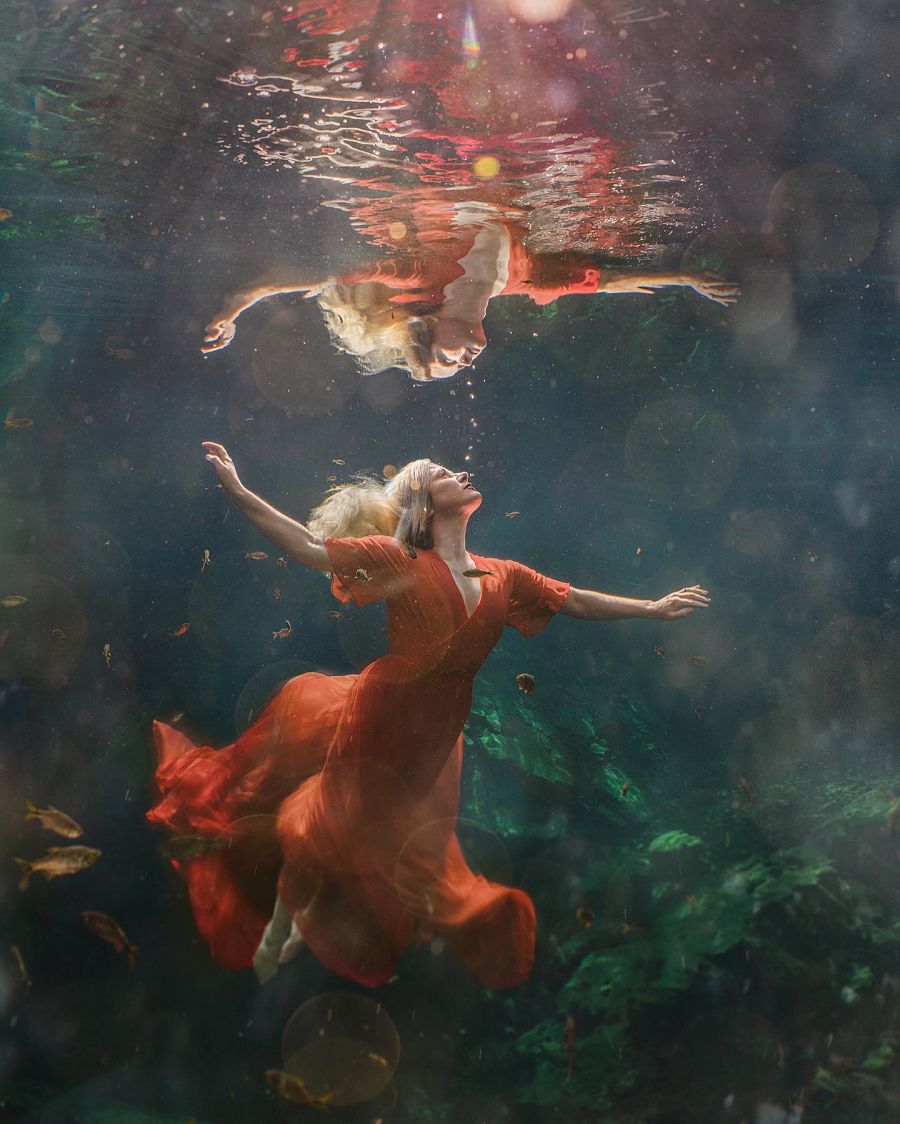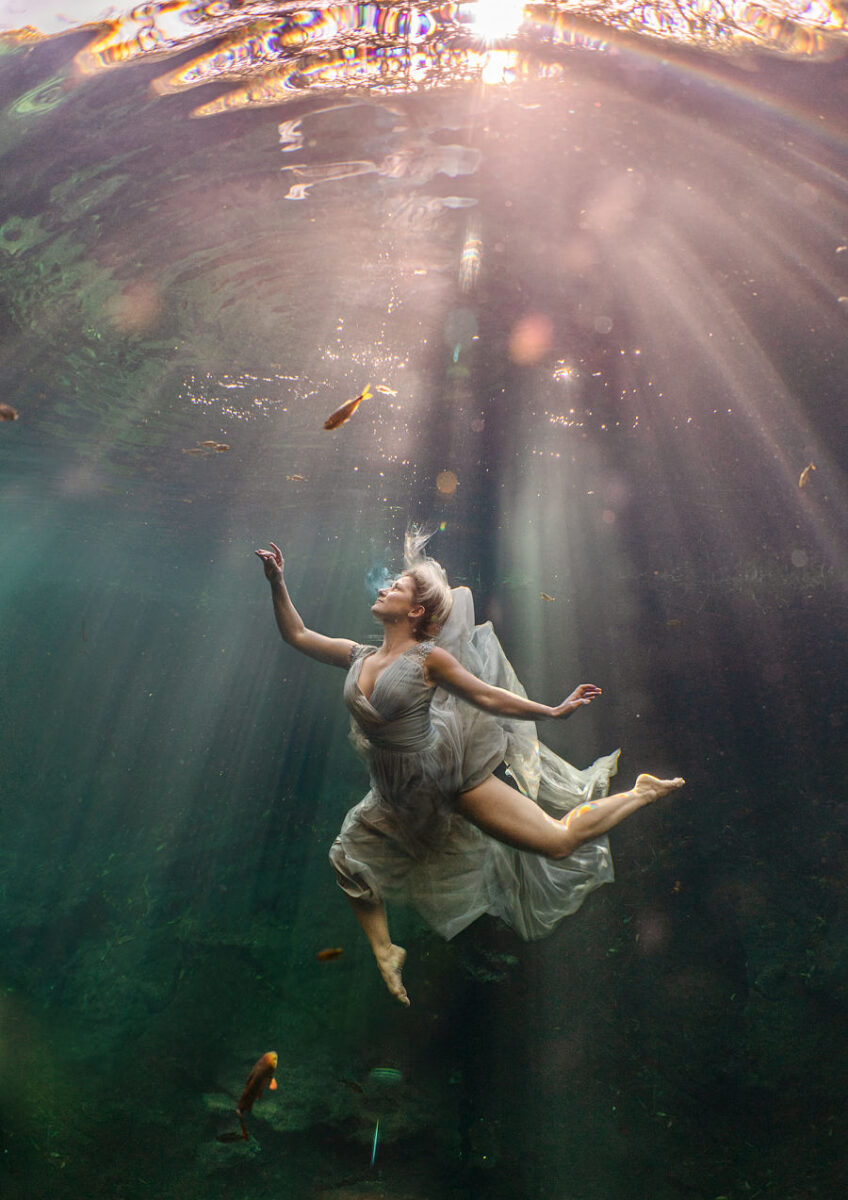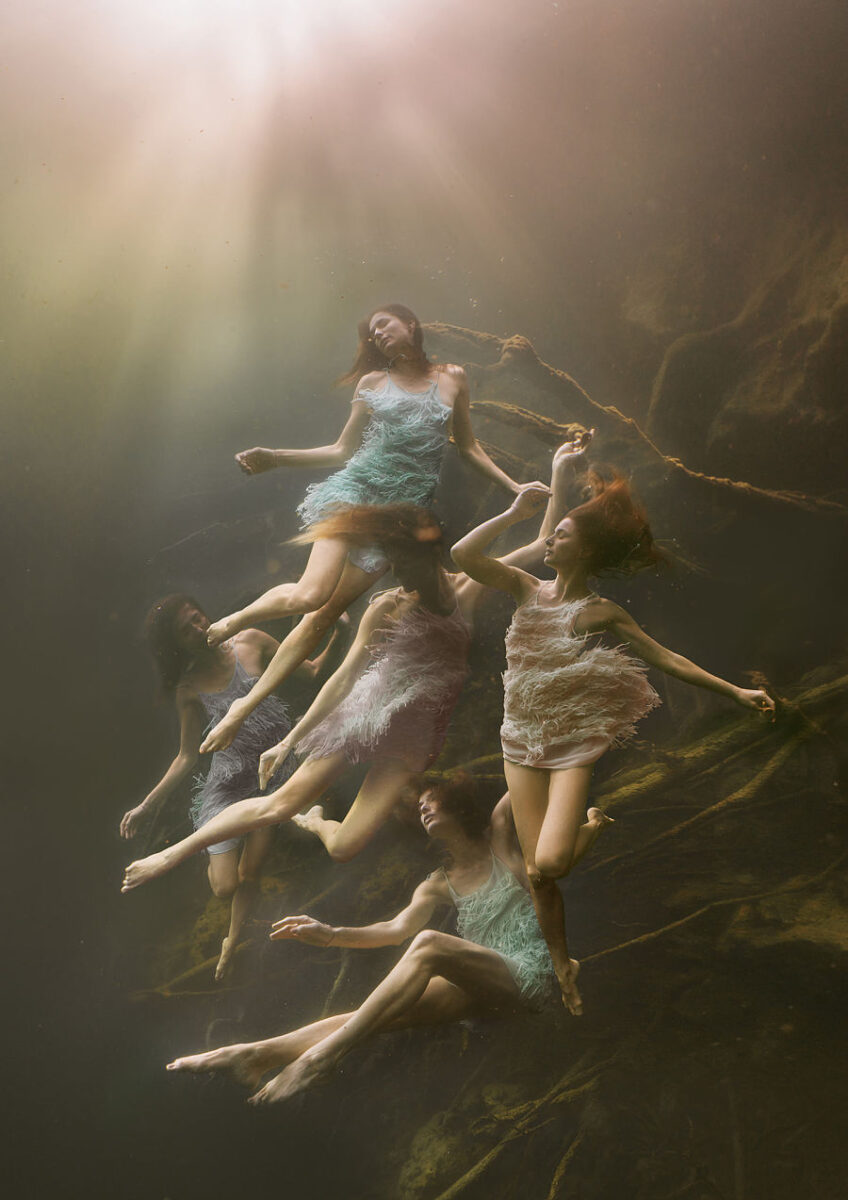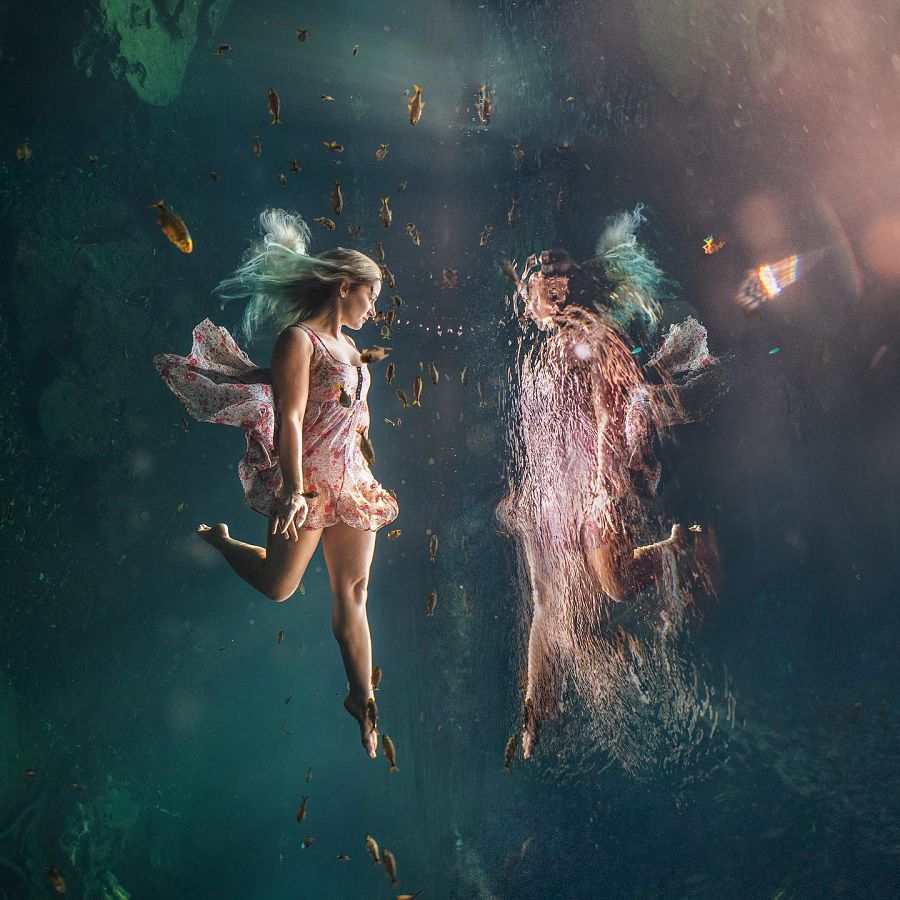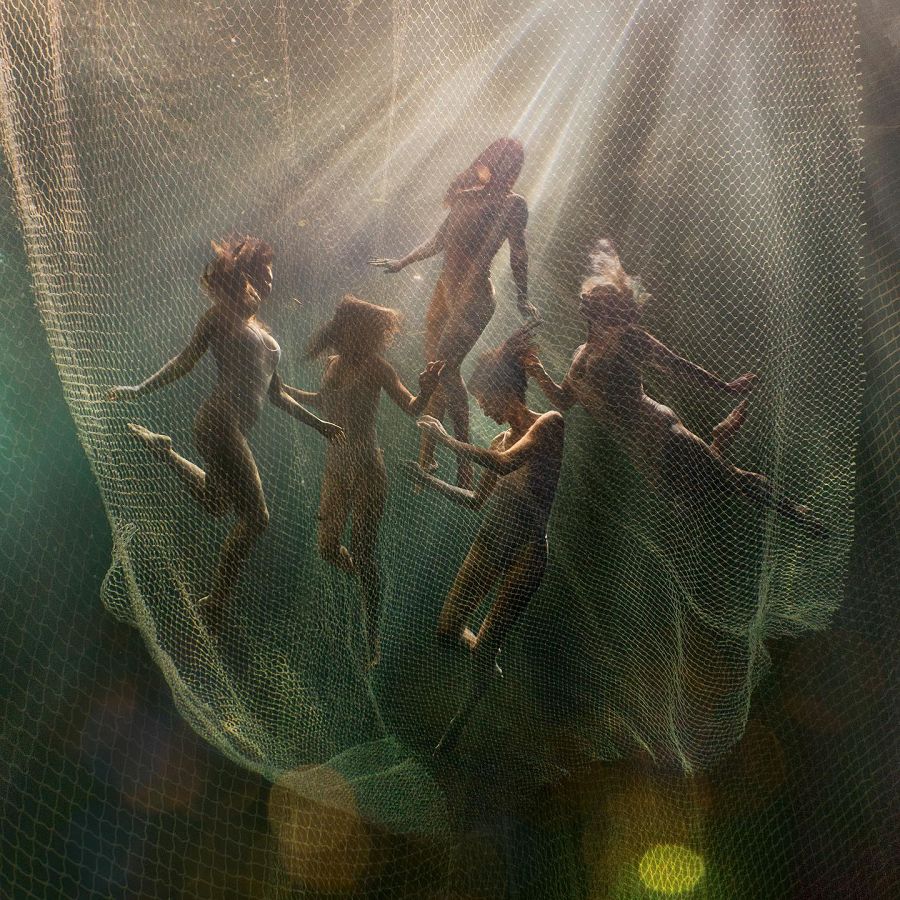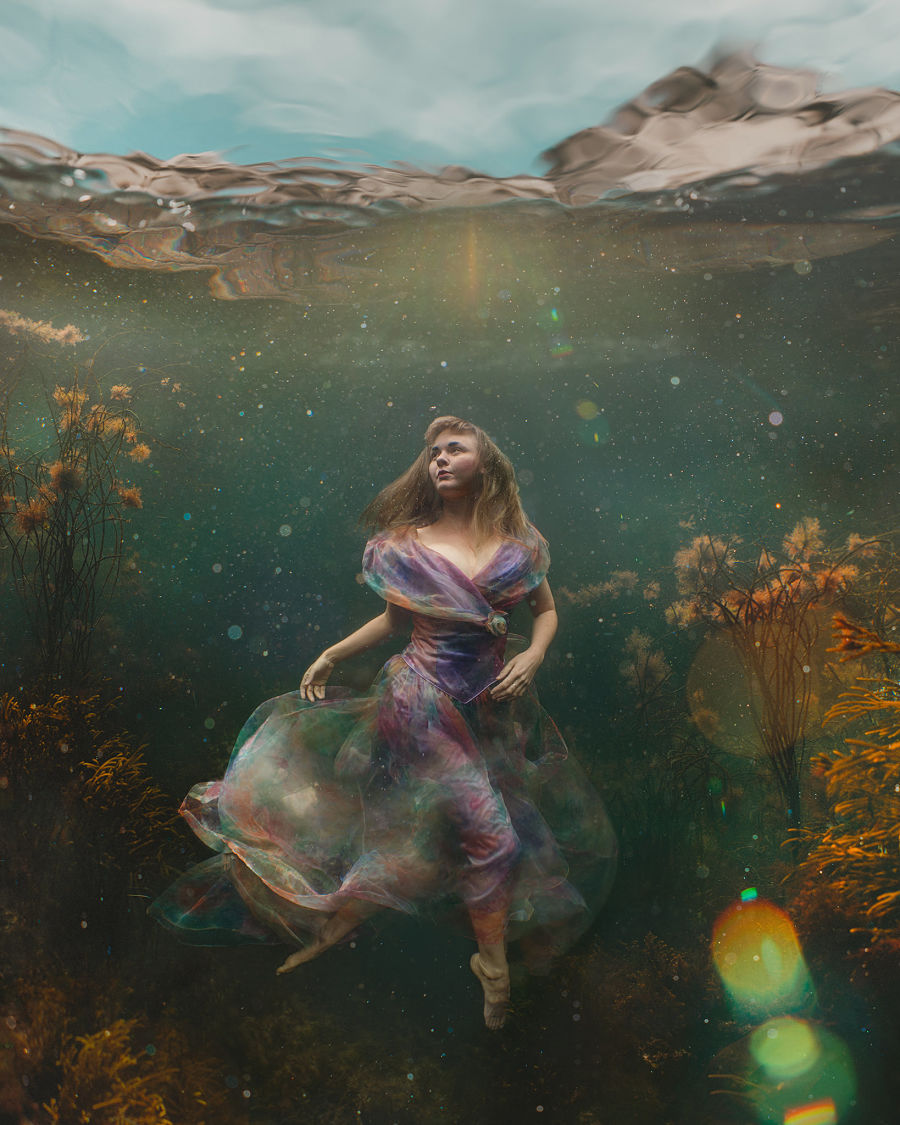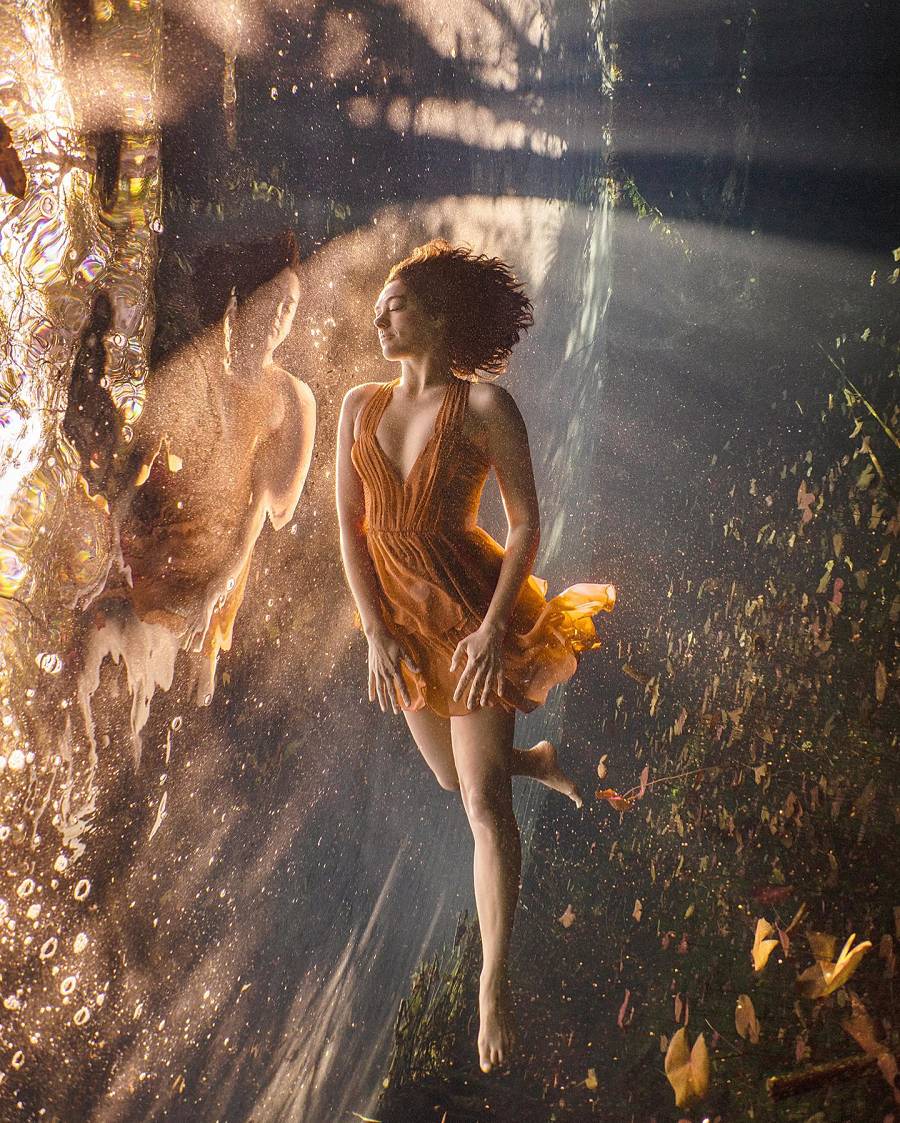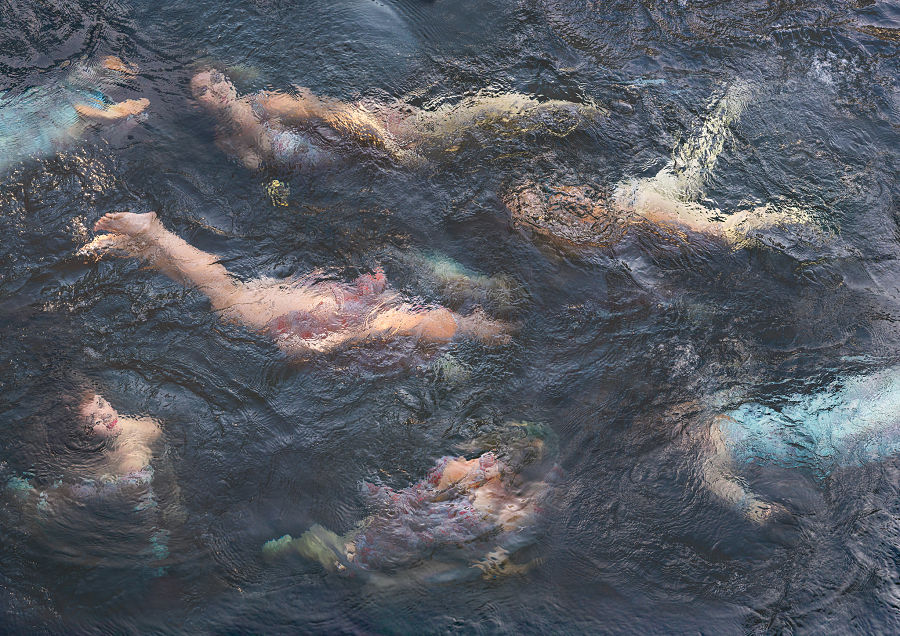Exclusive Interview with Lexi Laine, 1st Prize Winner, iCanvas Photography Award, 2020 Beautiful Bizarre Art Prize
Lexi Laine, a British based photographer, travels the world with her camera in search of magical light and clear water. A life long passion for water and the arts has transformed her photography into an ethereal and otherworldly experience. Beneath the surface Lexi’s lungs have learned to wait for air, while her creative mind is given permission to flourish in the serene quiet. Continue reading to discover Lexi Laine’s sacred relationship with water and the process behind these awe inspiring compositions.
Enter the 2021 Beautiful Bizarre Art Prize in any of the four Award categories: RAYMAR Traditional Art Award, INPRNT Photography Award, iCanvas Digital Art Award, Yasha Young Projects Sculpture Award, plus our People’s Choice Award, for your chance to receive global exposure for your work and share in over US$45,000 in cash and prizes!
I take a deep breath and dive meters down under the surface, quickly getting myself into the correct position in relation to the model and the light. I am operating shutter speed, aperture, ISO and focal points on the camera. I am making creative decisions. I am controlling my buoyancy so I don’t sink too deep, or float up too quickly. I am watching for the perfect moments to arrive. I shoot until the burning in my lungs as the CO2 levels build up force me to leave. I shoot until the very last moment before making my way to the surface.
Interview with Lexi Laine by Jacqueline Weinreb
The biggest symbol in your photography is water. What does water mean to you and what does it symbolize in your body of work?
There is no place where I’m more happy than when I’m in water. Sea swimming, exploring wild environments or even simply exercising in pools. I, like so many people, have a draw to the water that is hard to explain. I think it must have something to do with our evolution as humans, it is believed that all life once originated in the ocean after all. In my imagery, water represents how different this part of our world is from the places we typically inhabit. One of the things I love about shooting underwater is how the water itself is a means to defy gravity. It can hold the figures suspended in space and it can allow them to slowly rise as if flying towards the heavens. More often than not, my photographs celebrate the beauty of this otherworldly place but with this often comes the sadness of how we as humans mistreat this vital resource.
You mention that you view the surface of the water as a portal between two very different worlds. What can you tell us about these two worlds?
It feels like our above water world is getting busier and louder by the day. Being underwater is a form of meditation and escape for me. It is so quiet and calming being completely surrounded by water. When I’m making photographs underwater, the surface does definitely represent this separation between two completely different spaces. Visually, sometimes you can see glimpses of the ‘real’ world but often what I love about the surface is that it completely reflects back what is underneath. I just love playing with these reflections in my work as it can look like a portal into the unknown or create a ‘through the looking glass’ effect.
When you photograph a model in the underwater realm, do you view them as visitors to this world or do they inhabit this space fully? What story do the models help tell?
I think that there are people who exist in this world who are just as comfortable (or more so) underwater as they are above water. The people who I photograph aren’t necessarily professional models; more often they are natural water babies like me, who I form wonderful creative friendships with. This is the most important criteria, they need to inhabit the underwater spaces fully, perhaps even more so than I do. It’s such a wonderful feeling when I find like minded people to me who seem to ‘get’ my vision and who are as passionate about the underwater environment as I am. Looking back, I think I first started making photographs of solo women underwater as a means of self portraiture or self expression really.
On your website you state that you are always in search of magical light. What are some of the biggest hurdles in finding light under the water? How does weather affect your photography and photoshoots? Do you ever use flash or rely solely on the light from the sun?
Yes for sure, like all photographers, magic light is what I search for! I think the biggest hurdle for what I do is the weather. Often I will go on trips to interesting underwater locations, but the weather can not only affect the quality of light but also the clarity of the water – two of the most essential elements in my work. I have become very used to getting up before dawn, driving to a location only to find that the water has far too much churned up sediment in it. When all elements do actually come together it’s the best feeling in the world. I have in the past used artificial lighting, but nowadays I prefer just to use the sun, there’s something very pure about working purely with natural elements.
I think that I began photographing women in dresses as a way to avoid sexual connotations and also I guess to make them seem more surreal and out of place. I think this is really what I enjoy trying to achieve more than anything else; images where the subjects look entirely incongruous whilst at the same time completely natural looking.
I noticed that many of your models wear gowns. How do you decide the wardrobe for your photographs?
One of the reasons I first started photographing women in clothes was in response to how we normally see women photographed underwater, and also how women are largely represented in the history of art. I have always been interested in how women feature in art and my dissertation at art school was called ‘A New Nudity’. It discussed the work of three contemporary female artists; Vanessa Beecroft, Jenny Saville and Jemima Stehli who all featured the female nude in their work. As a feminist, I am interested in how female artists can reclaim this subject that was historically so depicted by men. And I have photographed nudes myself, both in the water and above water. I think that I began photographing women in dresses as a way to avoid sexual connotations and also I guess to make them seem more surreal and out of place. I think this is really what I enjoy trying to achieve more than anything else; images where the subjects look entirely incongruous whilst at the same time completely natural looking. Aesthetically, the way fabric can appear underwater is just like a complete dream to me. I think it reminds me of the way drapery has been used for centuries in the paintings of old ‘masters’. I love making images that are somehow reminiscent of baroque ceiling frescoes or heavenly scenes in renaissance art. When it comes to how to choose particular garments, it really depends. A lot of the time I scour second hand shops for vintage items. I feel like certain dresses can be the starting point for an idea or a narrative in my work. I like the idea that vintage dresses are holding a story of who first owned them. Almost as if the model will put it on and become a different person, sometimes emboldened and other times they represent a sort of tragic figure but always telling a story.
I read that you have taken certifications to be a freediver. How long did this take and what compelled you to start working underwater?
I started taking photographs underwater long before I ‘officially’ became a freediver. It’s always been the obvious choice for me to take photographs whilst holding my breath. My models have to hold their breath in order to pose for the shots so I’ve always thought that I should be experiencing the same sensations as them. It gives me such a connection to them and also the environment in which we work. I joined my local freediving club three years ago with the hope that through training I would be able to extend the amount of time I can stay underwater. What I discovered was an enjoyment for the sport in its own right. I currently train twice a week and really these sessions are where I switch off from the hecticness of life, it’s like hitting a reset button. Freediving is meditative, relaxing and something I would recommend to anyone to try. It’s been life changing for me.
Do the models need special diving instruction? What challenges have you faced working with models in this unique manner?
Often other freedivers have a natural love for being underwater so I’ve found a couple of my models this way but, also some of the best people I’ve worked with didn’t have any formal training to begin with. I think it’s those folk who, as kids, spent their summers in the sea, diving down to collect shells. They are the people who I’m looking to meet. Currently, I only really work with a small handful of models, mainly because it is so hard to find people who truly look natural in the water. And it’s also about trust; it takes time to build up a relationship where we can know each other well enough to connect. I am hoping in the future I might be able to diversify in the types of people who I work with, as this is something I’ve struggled with before. I am aware of how white and vaguely similar physiques the models are who I normally work with and this saddens me.
To give you an idea, I take a deep breath and dive meters down under the surface, quickly getting myself into the correct position in relation to the model and the light. I am operating shutter speed, aperture, ISO and focal points on the camera. I am making creative decisions. I am controlling my buoyancy so I don’t sink too deep, or float up too quickly. I am watching for the perfect moments to arrive. I shoot until the burning in my lungs as the CO2 levels build up force me to leave. I shoot until the very last moment before making my way to the surface.
There are many fascinating and compelling aspects of your work, but one element that intrigued me was the remnants that are visible of our terrestrial world from below the surface of the water. It almost reminds me of seeing the Earth from outer space. Is this a planned aspect of your work? If so, what does it signify?
Thank you, that’s very kind. And thank you for noticing that, I love that you see these glimpses as being from outer space. I like how this can look this way sometimes, it’s certainly a feature I like to play with. One of my favourite genres of books/movies is anything dystopian so I often imagine that some of the scenes I depict are actually showing a world in our future where a small handful of people have adapted to live underwater. It’s a fantasy I know but one thing that is for certain, the way we humans are treating our planet is leading us down a very dangerous path.
What are the biggest challenges of underwater photography and what was the most challenging image to create?
I think other than the challenges that are out of my control, such as the weather and water clarity, the biggest challenge is the physical nature of freediving and photography combined. To give you an idea, I take a deep breath and dive meters down under the surface, quickly getting myself into the correct position in relation to the model and the light. I am operating shutter speed, aperture, ISO and focal points on the camera. I am making creative decisions. I am controlling my buoyancy so I don’t sink too deep, or float up too quickly. I am watching for the perfect moments to arrive. I shoot until the burning in my lungs as the CO2 levels build up force me to leave. I shoot until the very last moment before making my way to the surface. I look out for low hanging rocks just above the surface or anything else that might cause me an injury (a lesson learnt from experience) I bring my head above the water and sip the fresh air, slowly bringing my breaths back to normal again. I chat with my model, discuss new ideas then repeat.
To answer the second part of your question, I think the most challenging image to make to date is ‘Cardumen’ for which I won the Beautiful Bizarre Art Prize iCanvas Photography Award. This image is comprised of five images of a woman called Flavia Eberhard, a model and freedive champion who I was lucky enough to work with earlier this year. The shoot was challenging for several reasons, firstly because the cenote in which we were shooting had a halocline ‘cloud’, which basically meant that the first three or four meters of water at the surface was thick and had zero visibility. It meant that we needed to dive down, swimming blindly until all of a sudden the water turned to perfect clarity. It’s such a hard thing to navigate and challenging for me with a mask on but even harder for Flavia who is even more blind because of a lack of mask. There were loads of creepy branches down under the cloud and I asked Flavia to see if she could get hold of one and pose next to it. The diffused light coming down through the cloud was heavenly so I hoped that we would be able to make something in spite of the challenge. The second thing I found slightly challenging about this shoot was the fact we had a film crew with us that day – they were making a documentary about a day in the life of Flavia, where she lives in Tulum, Mexico. Every time we came to the surface to breathe (bearing in mind that we were probably staying under for longer because of the distance to where we were shooting) the film crew who were on the side of the cenote were asking me interview questions like ‘so, how’s it looking under there’ or ‘can you tell us a bit about your ideas’ I was so out of breath it was embarrassing! And the final challenge was for me to make the most of these images in post. I knew at the time of shooting I wanted to achieve something special and different with this series of images. The way Flavia moves in the water is so beautiful and can only be described as if she was gently and rhythmically moving back and forth with the pull of a current. I wanted to show the same movement in a still image as if it were a moving piece of footage which is why I combined the five images together.
This piece is titled ‘Cardumen’, meaning shoal in Spanish. I love to work with light in a way that makes images seem more painterly and this soft diffused light was brilliant for making this scene almost heavenly.
What is your favorite location that you have photographed and what was your favorite image that you have created?
It’s a tricky question and I think I would have to answer two places. I love nothing more than being in the crystal clear waters of the Mediterranean sea. Having spent a large part of my childhood on the Balearic Island of Formentera, it’s a place I return to as often as possible. But that said, the times I have spent in Mexico have been incredibly special. The cenotes of Mexico are freshwater pools which form when the limestone bedrock collapses, exposing the groundwater beneath. They were sacred to the ancient Mayans and they believed them to be getaways to the afterlife. They would use them to make sacrifices – human remains have been found in some of them! I find the mystery of their pasts to be so magical and inspiring.
What do you love most about underwater photography and photography in general?
Photography, as a medium, is something I began doing in art school. I loved the process of loading my film, choosing what to shoot, then spending hours in the darkroom developing and printing. At the time I had only really seen painting as a way to express myself. This new discovery allowed me to have a level of control and immediacy that I never achieved through painting, whilst at the same time having a creative playfulness that allowed me to experiment and push my own boundaries. My first underwater camera was a 35mm Nikonos and it was hilarious how hit and miss my images were (mainly miss may I add). What I love most about underwater photography is that it perfectly combines my love of art and water.
A most memorable location would be a time I was shooting in some mangroves with a friend/model. The roots of the mangroves were growing into the water so it made an interesting backdrop. I had clambered into the roots and was on the surface in between shots when I noticed a pretty huge crocodile asleep next to me. That moment was one I will always remember, trying to quietly swim away without waking him!
How do you scout locations for your photography? What has been one the most memorable locations?
Location scouting can be very time consuming and frustrating. When planning trips to new locations, I spend a long time researching as much as I can online, through travel blogs, Instagram and looking at satellite images of coastline. Then on arrival, I often spend days driving, walking, climbing and swimming as a means to explore. I do love this part of my work. At the same time it can be frustrating if I can’t find exactly what I’m looking for. The best kept secret locations can often be found through working with guides so I always seek out local knowledge when visiting new places. A most memorable location would be a time I was shooting in some mangroves with a friend/model. The roots of the mangroves were growing into the water so it made an interesting backdrop. I had clambered into the roots and was on the surface in between shots when I noticed a pretty huge crocodile asleep next to me. That moment was one I will always remember, trying to quietly swim away without waking him!
I can imagine that you need specialized gear to protect your camera, can you tell us more about the process? Has your camera ever gotten wet or compromised in anyway?
I work with Sony cameras, the A7Riii mainly. The camera needs to be protected by a housing and I use one made especially for the camera by Nauticam. It’s a sturdy beast made out of aluminum and it costs as much as the camera and lens combined. I often hike to locations with this heavy kit on my back along with several big dresses and a weight belt! The whole kit is big and bulky but it becomes much lighter when in the water, thank goodness. The housing is very robust and has several fail safe features that prevent it from leaking and making my camera wet. I have never had a housing related accident in the past and fingers crossed I never will!
If you Google ‘ghost nets’ and look at images, you will see the horrors of beautiful turtles, seals, dolphins and whales entangled in this dangerous ocean waste. An estimated 640,000 tons of this fishing gear ends up dumped in the ocean every year.
I read that you believe strongly in ocean conservation. How would you say your work speaks to this cause and what would you like people to learn from your work?
Yes, indeed I do; I think anyone who spends and time in the water will realise what a desperate time we live in. I made a piece recently featuring five fearless freediving women as subjects, seemingly trapped in a net. It is titled ‘Ghost Nets’ and is named after commercial fishing nets that have been lost or discarded at sea. These often nearly invisible nets can be left tangled on a reef or drifting in the open sea. If you Google ‘ghost nets’ and look at images, you will see the horrors of beautiful turtles, seals, dolphins and whales entangled in this dangerous ocean waste. An estimated 640,000 tons of this fishing gear ends up dumped in the ocean every year. I wanted to make an image that on first appearance is beautiful, with ethereal figures and nice light. But I also wanted to demonstrate the sadness and darkness that I feel when I see ghost nets in the ocean. Seeing women seemingly trapped here is shocking, yet this is what we do to beautiful ocean animals all the time. This is just one piece of work that I have made that seeks to raise awareness of otherwise hidden ocean problems. There are many incredible charities that do great work in ocean conservation and my absolute dream would be to work on a campaign with one of them.
*I should mention that the women were photographed behind a net rather than actually caught in one. Safety is my number one concern when working with models and having safety divers present is always necessary when shooting something complicated like this.*
How long are you able to hold your breath and how long do you typically spend under the water at a time?
My personal best is around three and a half minutes in a static breath hold, which is nothing in comparison to what a lot of freedivers can achieve. I think the world record is around twelve minutes! But really the length of time I stay underwater when shooting is often only a minute or two anyway. I always say to models who I work with, it’s much better to stay underwater for a shorter amount of time and achieve a state of true relaxation, than it is to stay in too long and appear uncomfortable the whole time.
What is the most unexpected thing that has happened as a result of your artistic career?
I’m in my relatively early stages of my career so hopefully the best is yet to come. I think other than winning the Beautiful Bizarre Art Prize iCanvas Photography Award I would say the opportunity I was given to shoot a behind the scenes documentary about my work, a project that Sony UK kindly sponsored me to do.
Why did you enter the Beautiful Bizarre Magazine Art Prize?
Firstly, I find Beautiful Bizarre Magazine very inspiring; the diversity in the types of work and artists you can learn about in this publication is brilliant. When I first heard about the Beautiful Bizarre Art Prize, I entered it without a second thought. It was the first time I had discovered an area of the art world where I felt like my work might actually fit in. Maybe because the magazine largely features representative art that seems to me to be filled with narrative and emotion. Or maybe because I strive to make art, which is both beautiful and bizarre! I didn’t think anything would come of me entering the competition other than hopefully getting my work seen by some important people in the industry. To be shortlisted as a finalist alone was the most exciting moment in my career to date. A lot of the other finalists are artists I have followed and admired for years so to be held in the same regard as them blew my mind.
What do you feel you have gained from this experience?
The validation this has given me personally is totally priceless. I think imposter syndrome is one of my biggest challenges I constantly battle with. Receiving this prestigious award has given me confidence and tells me that what I’m doing is worthy. And it tells other people that same message, collectors and galleries can see that this is something that I have achieved and this helps to make me stand out. Not to mention the incredibly generous prizes that I won as well, I’m still pinching myself if I’m honest. Having my work exhibited in the Modern Eden Gallery in San Francisco is so cool! The prize money is going towards a trip to Mexico to build a whole new body of work some time in the hopefully not too distant future. I am grateful beyond words for all of this.
Would you recommend it and encourage others to enter? If so, why?
I know people always say that just entering a competition is a good experience and I have to agree. Not only does it make you really question which pieces of work are the best in your portfolio but it also makes you consider everything around how and why you make art. Regularly writing about my art helps me to understand myself better, it steers the direction of my art practice and it inspires new ideas. Entering competitions also builds resilience. I have entered plenty of competitions before, and have had plenty of rejections. I would say my advice is to be selective and seek out competitions that really suit your work. One of the many things I love about the Beautiful Bizarre Art Prize is they have categories for four different art mediums. Which means that my photograph isn’t being judged against a painting or sculpture or a piece of digital art. It feels like it holds each of these mediums to equal importance and I really like that.


